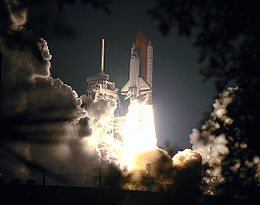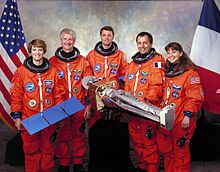STS-93

Columbia launches from LC-39B
|
|
| Mission type | Satellite deployment |
|---|---|
| Operator | NASA |
| COSPAR ID | 1999-040A |
| SATCAT no. | 25866 |
| Mission duration | 4 days, 22 hours, 50 minutes, 18 seconds |
| Distance travelled | 2,890,000 kilometers (1,800,000 mi) |
| Orbits completed | 80 |
| Spacecraft properties | |
| Spacecraft | Space Shuttle Columbia |
| Launch mass | 122,536 kilograms (270,146 lb) |
| Landing mass | 99,783 kilograms (219,984 lb) |
| Payload mass | 22,781 kilograms (50,224 lb) |
| Crew | |
| Crew size | 5 |
| Members |
Eileen M. Collins Jeffrey S. Ashby Michel Tognini Steven A. Hawley Catherine G. Coleman |
| Start of mission | |
| Launch date | 23 July 1999, 04:31:00 UTC |
| Launch site | Kennedy LC-39B |
| End of mission | |
| Landing date | 28 July 1999, 03:20:35 UTC |
| Landing site | Kennedy SLF Runway 33 |
| Orbital parameters | |
| Reference system | Geocentric |
| Regime | Low Earth |
| Perigee | 260 kilometres (160 mi) |
| Apogee | 280 kilometres (170 mi) |
| Inclination | 28.4 degrees |
| Period | 90 minutes |
 Left to right: Collins, Hawley, Ashby, Tognini, Coleman |
|
STS-93 marked the 95th launch of the Space Shuttle, the 26th launch of Columbia, and the 21st night launch of a Space Shuttle. Eileen Collins became the first female shuttle Commander on this flight. Its primary payload was the Chandra X-ray Observatory. It would also be the last mission of Columbia until March 2002. During the interim, Columbia would be out of service for upgrading, and would not fly again until STS-109. The launch was originally scheduled for 20 July but the launch was aborted at T−7 seconds. The successful launch of the flight occurred 3 days later.
During the main engine ignition sequence, a gold pin used to plug an oxidizer post in the Space Shuttle's third (right) engine came loose and was violently ejected, striking the engine nozzle's inner surface and tearing open three cooling tubes containing hydrogen. These ruptures resulted in a leak downstream of the main combustion chamber. This anomalous event and the automatic response to the leak by the right engine's controller did not violate any launch commit criteria and liftoff proceeded normally. However, approximately 5 seconds after liftoff, an electrical short disabled the central engine's primary digital control unit, DCU-A, and the right engine's backup unit, DCU-B. The central and right engines continued to operate on their remaining DCUs for the rest of powered flight to orbit. The redundant set of DCUs in each engine controller saved Columbia and her crew from potential catastrophe, as shutdown of two engines at that point in the flight would have resulted in a very risky contingency abort with no guarantee of success. The electrical short was later discovered to have been caused by poorly routed wiring, which had rubbed on an exposed screw head. This wiring issue led to a program-wide inspection of the wiring in all orbiters. Because of the leak in the right engine, its controller sensed a decrease in power or thrust—measured indirectly as main combustion chamber pressure—since the leaking hydrogen was not being burned in the SSME's two pre-burners or the main combustion chamber. To bring the engine back up to the commanded thrust level, the controller opened the oxidizer values a bit more than normal. The hydrogen leak and increased oxidizer consumption resulted in the right engine deviating from the desired oxygen/hydrogen mixing ratio of 6.03 and running hotter than normal due to the mixture being closer to the stoichiometric ratio of 8:1. The increased oxidizer consumption during ascent resulted in a premature shutdown of all three engines near the end of the projected burn due to low liquid-oxygen level sensed in the External Tank. Though the premature shutdown resulted in a velocity 15 ft/s (4.6 m/s) lower than targeted, the vehicle safely achieved its intended orbit and completed the mission as planned. This incident brought on a maintenance practice change that required damaged oxidizer posts to be removed and replaced as opposed to being intentionally plugged, as was the practice beforehand.
...
Wikipedia

